Recent Water Damage Posts
Moisture Leads to Microbial Growth
6/8/2022 (Permalink)
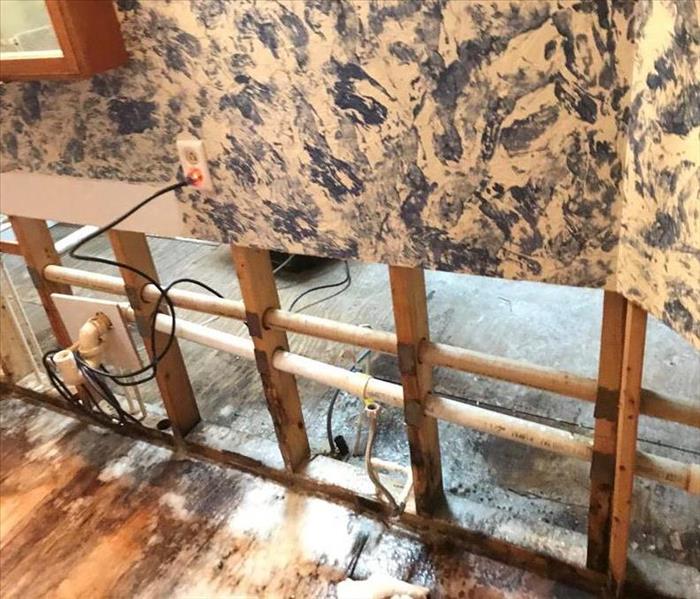 If your property needs to be evaluated for water damage call SERVPRO of Marshall, Sedalia and Columbia at 660-886-5194.
If your property needs to be evaluated for water damage call SERVPRO of Marshall, Sedalia and Columbia at 660-886-5194.
We send one of our Project Managers to a property instead of accepting images because we can’t engage our other senses with images. The biggest sense that we can’t engage is the sense of smell; our Project Managers know what to smell to tell how severe the job is. If a property has standing water, we must consider factors such as microbial growth. With us being in the warmer months, properties have a higher chance of microbial growth with the added humidity in the air. By following these easy controllable steps, you can ensure your property doesn’t fall victim to microbial growth.
- Microbial Growth needs specific conditions to flourish, one being moisture in the air. Adding moisture to your home’s air quality can stem from multiple sources, so finding what is causing the moisture needs to be the focus immediately. This could be flood water, dishwasher leak, or as simple as having the water vapor from a boiling pot of water.
- Everything that is a living organism needs a food source to thrive. Microbial growth also needs a food source, and some of the most common household materials that promote growth are wood, cardboard, textiles, and dust-containing skin cells.
- We all know that temperatures during the summer are unbearable at times; well, microbial growth thrives in temperatures ranging from 41 to 104?, which is what we keep our homes at.
- Finally, Oxygen is the last factor that can control microbial growth.
You Have To Watch Out For Those Ice Dams
1/5/2022 (Permalink)
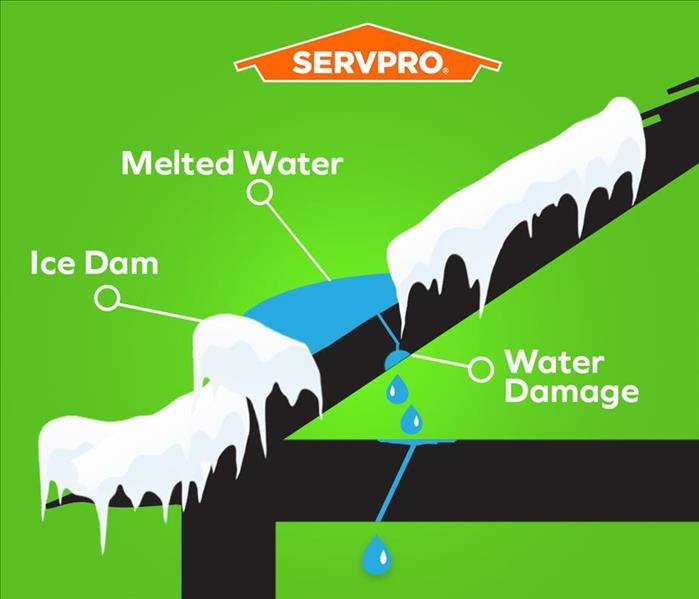 As you can see from the SERVPRO diagram that the snow/ice melts and freezes on the slope of the roof creating ice dams.
As you can see from the SERVPRO diagram that the snow/ice melts and freezes on the slope of the roof creating ice dams.
An Ice What?
If you have never heard of an ice dam before, a roof has nonuniform roof surface temperatures that cause the snow and ice to melt. This becomes problematic because it refreezes on the areas of the roof that is frozen. This causes pools of water to sit on the roof with nowhere to go. The water will find cracks and come in through the exterior roof coverings, which seep into the attic. I wish it stopped there, but there is the chance that it can flow into the exterior walls or through the ceiling insulation, which will stain the ceiling finish.
Nonuniform Rood Surface Temperatures
The primary source that causes ice dams is the source of heat/energy that melts certain frozen areas on the roof. When certain spots on the sloped roof melt, there is a heat source on the inner side. There are three ways that the ice on the slope can melt:
Conduction is when the heat/energy travels through a solid, insulation, and roof structure.
Convection is when heat/energy is transferred from rising air to your hand, roof.
Finally, heat/energy can be transmitted by electromagnetic waves known as radiation.
To avoid a heating source from being created, you should ensure that all access points to the attic are well-sealed so no heat escapes through the ceiling. These are just a few ways to be proactive in preventing ice dams from forming.
Limiting the Heating Source by Adding Insulation
One way to eliminate the possibility of having access to heat/energy from escaping your home is by installing more insulation. When installing insulation, you should find one with a high R-value per inch to ensure all heat stays in the house.
Purchasing A Roof Rake
If you cannot install more insulation, you could always hire SERVPRO but purchase a roof rake. This tool can help pull down access snow to help minimize the source of the water damage.
If you find yourself in a winter wonderland of a mess, please reach out by CALLING US at 888-886-5195; you can call the local Marshall number 660-886-5194 or the Columbia location at 573-449-1999.
Categories of Contaminated Water
12/13/2021 (Permalink)
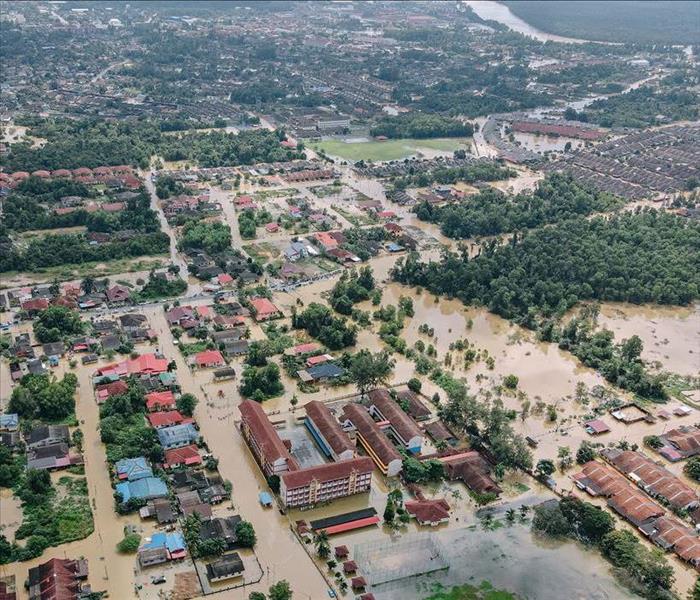 Widespread flooding can create contamination problems which bring harmful conditions.
Widespread flooding can create contamination problems which bring harmful conditions.
Sometimes we will call about a job that isn’t the most desirable, but we will never turn it down. A job site affected by a sewage leak or flooding can carry harmful bacteria that comes in contact with or is ingested can cause severe discomfort. When going into an area affected by a contaminated source, we will have our crew wear the complete PPE to secure their health and safety.
Categories of Contaminated Water
Category 1: “Clean Water”
This category is when a leak comes from a clean source from a broken water pipe. A toilet containing no urine or feces is considered a category one since it has no harmful pathogens. Category one floods will escalate to category 2 or 3 if it doesn’t get mitigated.
Category 2: “Gray Water”
In this category, you are looking for the possibility of contamination from a water source containing some degree of contamination. When gray water gets ingested, it can create some discomfort due to the ingestion of harmful bacteria.
Category 3: “Black Water”
Water contaminated by an unclean source will be considered category three because it has been affected by a source that has harmful pathogens. The difference between category 2 is that when category three gets ingested, it can create severe pain with the possibility of death due to these harmful pathogens. We will never suggest that our clients should put themselves in contact with this category for that reason. Flood water is an excellent example of this category because you cannot know where the source came from, such as a pipe, river, or sewage from an unclean source.
Prioritizing the Response
11/25/2021 (Permalink)
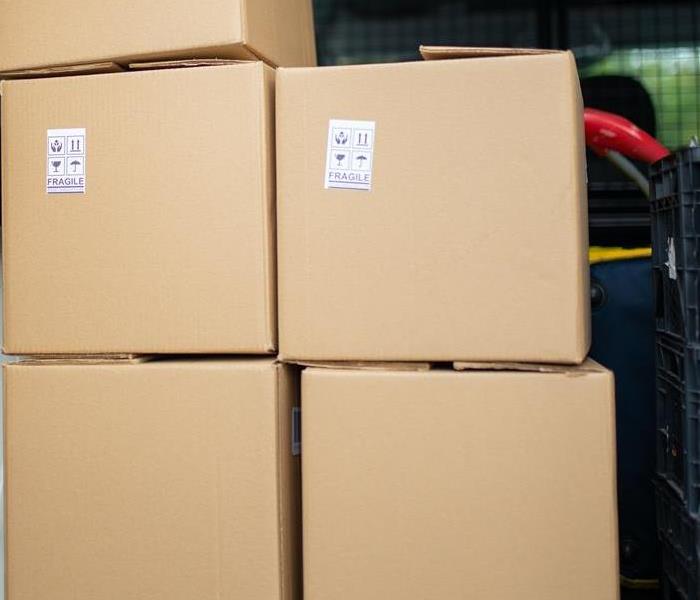 After you decide what you are keeping, we will hold onto it until it's ready to be picked up.
After you decide what you are keeping, we will hold onto it until it's ready to be picked up.
Every job site we go on, we see the devastation that is caused by uncontrollable accidents. How do you organize a job site where you want to be conscious that this is the client's home and everything has particular importance or meaning in their lives? We place affected items into three potential actions. Each action has its own set of pot entail deviations and considerations. This helps ensure we efficiently use the time to get the contents back and return to the preloss state faster.
Discard
There will be times when no amount of time or effort could go into the restoration of an item that could get it back to the preloss state. This is due to irreversible damage caused by the contact of moisture, contamination, or physical damage. Many items fitting this description should be listed on a schedule of loss, set aside for review by an adjuster, and, if approved, discarded and replaced. Exceptions can occur when an item's emotional or monetary value and the client decide to overlook the damage and accept the item in a less than preloss condition.
Restore Immediately
We encourage the client to talk to involved parties such as insurers or adjusters. We will take immediate action when dealing with items highly susceptible to secondary damage. Articles needing to be restored immediately play a significant role in increasing or decreasing the overall loss severity. The value of the item significantly influences a decision to repair, and photo documentation can help determine the value of these items.
Restore Later
Materials that suffered minor but repairable damage should be low on the priority list. These items face little risk of secondary damage since they weren't wet or suffered from short-term exposure to water. Do not spend time and energy in the first moments of mitigation time on these items.
Knowing where your contents belong in these categories will help ensure you spend your time on items with a more significant amount of meaning.
Melting Snow Creates Water Damage
11/15/2021 (Permalink)
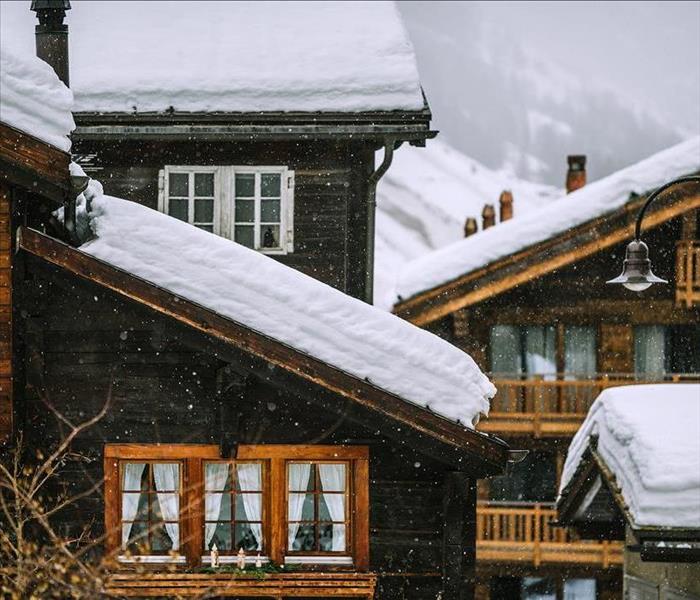 The winter storms create water damage but following our listed tips it can ensure that your being safe this winter.
The winter storms create water damage but following our listed tips it can ensure that your being safe this winter.
Being in the Midwest, we can all agree that it can be snowstorms one day, and the next, it will be direct sunlight. People often won’t associate snow melting with flooding issues as it isn’t as expected when the ice freezes near the structure, creating tiny cracks in the foundation. When the temperature rises in one of our weather mood swings, water can seep through these cracks.
Water Damage to the Carpets
Water the comes through these cracks can become problematic when the water into the drywall, hardwood floors, or carpets. It becomes dangerous when the water gets the carpet wet and when you combine that with the usually warm temperatures of the home, it can promote mold growth. The growth will thrive as many homeowners don’t allow ventilation outwards, but if you follow these tips, you can’t enjoy the snow with comfort.
Tip 1: Be Strategic with Shoveling
If your home is on a hill, you might want to be strategic when it comes to the flow of water that will be created when the snow melts. You will want to create a path that will allow the water to flow away from home.
Tip 2: Clear Excessive Snow off of the Roof
By not clearing the snow off of the roof, you are allowing the possibility of a room collapse that could create a more significant accident if the top were to cave in. When you are up on the roof, you might want to check the drains and clear out any frozen blockage. If you let the backup continue, you might put yourself into a situation of creating an ice dam.
Tip 3: Check Sump Pump
Testing the sump pump by pouring a bucket of water can show you that it is currently working. You must check the pump because it will help prevent flooding of the crawlspaces, around the foundation, and in the basement.
Don’t let the winter season bring you stress, so follow these tips and ensure that flooding won’t be in your holiday forecast.
Removing Moisture from Materials
11/15/2021 (Permalink)
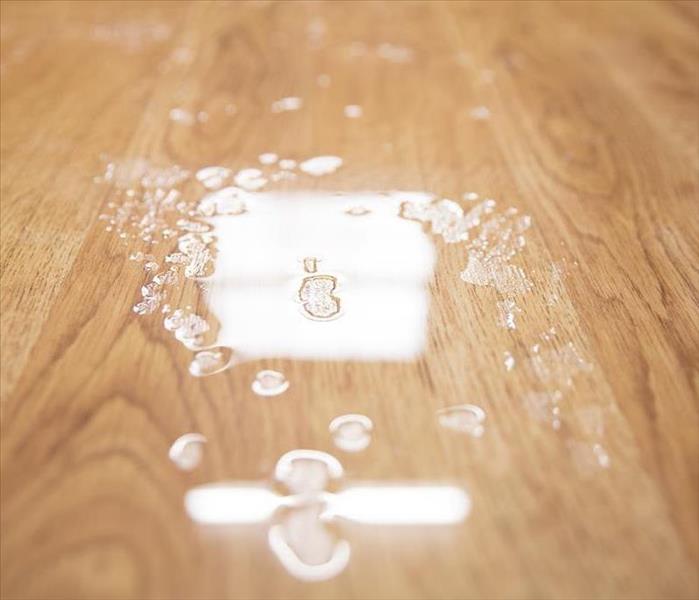 Materials can hold moisture in different ways.
Materials can hold moisture in different ways.
When looking at a project that involves water damage, we look at two factors: the type of material and the degree of wetness. We look at the variation of each material's permeability or the ability for water to pass through the material. The degree of wetness refers to the moisture movement by indicating the type of water being addressed. The liquids will be presented in one, two, or three forms.
Surface Water
Surface water can be found on the material's surface, making it a liquid, visible, and evaporates. When cleaning this type of water, it's essential to remove the moisture physically by using mechanical extraction equipment. By using different airflows which moderate temperature and humidity will evaporate the remaining water.
Free Water
Free water can be found within a material, but it hasn't bonded to the chemical bonds of the material. The moisture will be located in cavities, open pores, and other air spaces within these materials. Free water is a liquid that can generally be seen when the material is darkened, and this liquid can be evaporated. When extracting this type of water, you will have to use lower humidities and warmer temperatures. Monitoring these factors help maintain the rate of evaporation which ensures the liquid can evaporate.
Bound Water
Bounded water is a little more problematic as it is absorbed by the material and gets held by the chemical bonds. Due to the chemical bond holding in the moisture, you will have to release it before it can evaporate. Unlike the other types, controlling the airflow onto the material won't be successful. The fabric will successfully dry fastest when it is warmed, and it's essential to keep the surrounding humidity very low. Due to the chemical bonding, this type of absorption takes the longest out of the other.
The knowledge on what to look for is what separates SERVPRO from our competitors. Our Project Managers will go to a water-damaged job site and will be able to know what to look for to ensure that they will send our technicians with the right equipment to get the job done.
Don’t stress, This is How to Handle Water Damage.
11/15/2021 (Permalink)
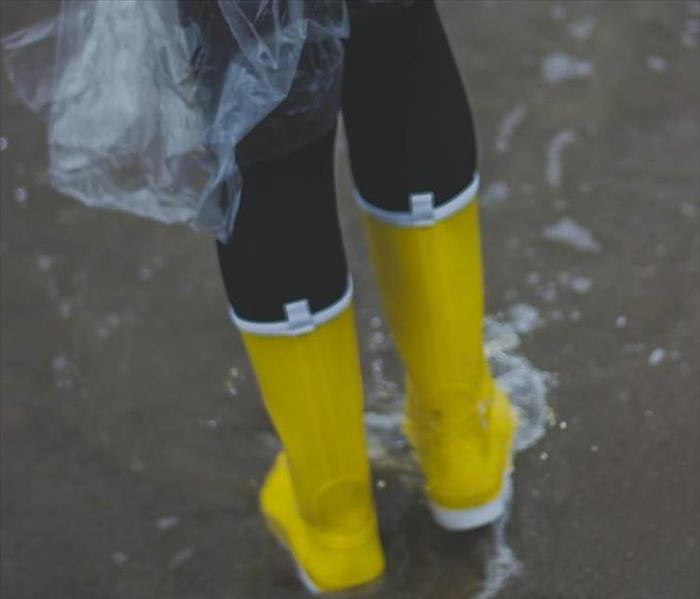 Taking these steps will help ensure you don't have to worry about water damage to your home.
Taking these steps will help ensure you don't have to worry about water damage to your home.
Okay, close your eyes. Imagine you are getting home from a long day at work, and you are going downstairs to grab a bag of chicken nuggets that your screaming kiddo wants for dinner. You are already one hay straw away from having a total meltdown. As you step off the bottom step and into standing water up to your ankles. This is when you shouldn’t stress because SERVPRO is here to help you.
Step 1: Call Your Insurance Agent
This is important as this is what will get the ball rolling. When you call your agent, you will tell them you have a claim to call in.
Step 2: Find the Source
A lot of times, people will associate a leak with heavy rain or storms. Here are a few other ways that you can have a flood in your home:
- Broken pipe
- Pipe burst due to cold weather
- Overflowing toilet or sink
- Crack in the foundation
Once you find the source, you can be able to provide essential information for our team. If you are part of our Emergency Ready Profile app, you will be able to pull up critical information about where you can locate the water shut-offs.
Step 3: Call us at SERVPRO; we got you!
After calling one of our 24/7 call representatives, they will have someone there as soon as possible. Our Project Manager will look at the current state of the accident and provide clear information to our technicians on how they should go about remediation. Some of the information they will tell their staff is how many air movers, dehumidifiers, or shop vacs will be needed for the job with a precise location on where it should be sat.
Step 4: Reconstruction?
Depending on the state of the emergency, you might need someone to come in and provide reconstruction services. Don’t worry; we still have your back. We can take on reconstruction services and specialized subcontractors to help complete any jobs from beginning to end.
These are just a few steps you should take when dealing with water damage. What we strive for is a complete destress for our clients. We want to take on the project to ensure that you can have one thing taken off of your plate.
How to STOP Mold Before it Starts
11/15/2021 (Permalink)
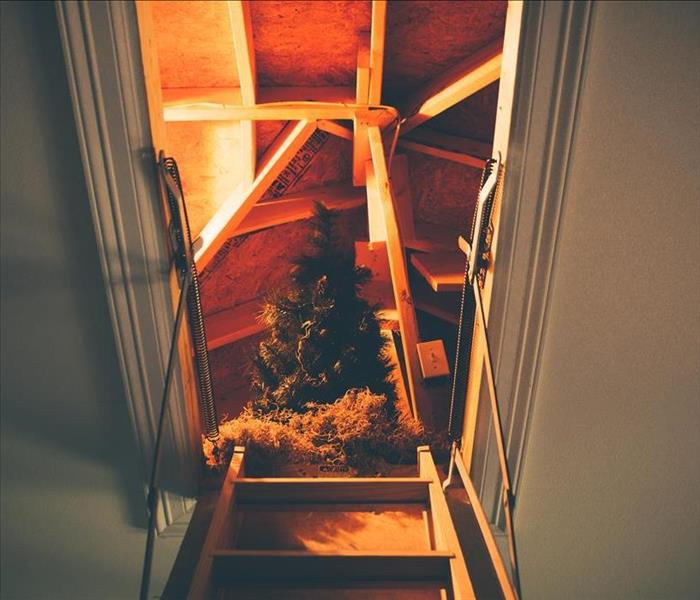 To ensure condensation doesn't grow mold in your home, follow these tips to prevent mold growth.
To ensure condensation doesn't grow mold in your home, follow these tips to prevent mold growth.
Due to the cold temperatures outside, most people will keep their homes at a higher temperature. The problem with this is that condensation can occur when the warm air from inside and the cold air come down upon the roof. This is more common in homes with poor insulation between the roof and the ceiling and the outer and inner walls. By preventing condensation helps to avoid mold from developing in your homes.
Snow melting is another contributor in homes with roof, basement, or foundations issues or homes with deep snow that lays against the house and seeps through small areas of unprotected exterior walls. By following these simple tips, you can avoid any unwanted mold growth.
Tip 1: Turn Ceiling fans to Reverse
When you run the fan in reverse, you change the airflow driving it upward instead of downward. This ensures that warm air circulation is created up by the ceiling, promoting the drying of any moisture in the air. The warm air will then flow down the walls, and this sometimes helps by drying the surfaces, which evaporates water from these surfaces. You will want to keep this method going, especially at night as the temperatures drop, even more, creating perfect mold development situations.
Tip 2: Check the Humidity and Condensation in the Attic
The length of snow that stays on your roof is a lot longer than a rainstorm in the summer. It is quite possible that when the snow melts on the roof, it could create dams. What you will want to do is that check to see if you see any insulation exposed. If you notice any insulation, you will want to call your trusted team at SERVPRO to help fix the problem before it grows.
The winter brings a lot of unseen problems that are hard to remember. Here at SERVPRO, we know what to look for to ensure you don’t let a bad situation worsen.
Mold Exposure from Flash Floods
6/29/2021 (Permalink)
Increased flooding in Mid-Missouri has caused longer wait times for restoration companies. But experts say people who have flood damage in their homes shouldn't wait to take steps against mold.
Ann Hisle with SERVPRO of Marshall, Sedalia and Columbia said mold can form in as little as 48 hours. Flooded areas inside homes should be dried as quickly as possible to reduce mold buildup. SERVPRO of Marshall, Sedalia and Columbia had 150 flood cleanup calls over the weekend.
"If you have things that are properly dried out on a water damage loss, the chances of mold are very slim," Hisle said.
Hisle said drywall is like a sponge and can cause mold to grow up the wall. So if you are experiencing any of these issues then call on the professionals to help you get your property back to normal.
Personal Protective Equipment
1/14/2021 (Permalink)
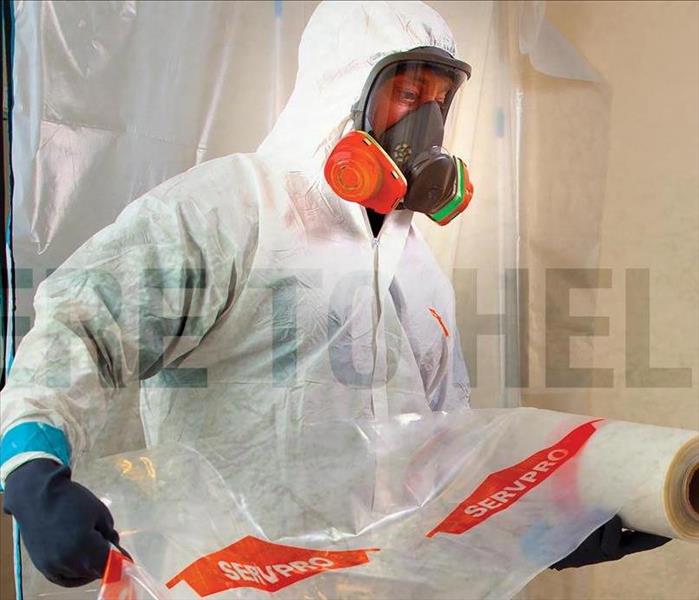 No matter if it is mold, sewer damage, or water intrusion, we have the equipment needed to handle the situation efficiently and thoroughly.
No matter if it is mold, sewer damage, or water intrusion, we have the equipment needed to handle the situation efficiently and thoroughly.
Personal Protective Equipment
As restorers and as professionals, our team members need to be prepared for potentially hazardous conditions. Personal Protective Equipment, PPE, is then implemented as a way to protect our team and the customer. Before using Personal Protective Equipment, the technician will closely evaluate the potential risk and determine the type of equipment is necessary for the job. This can also be referenced from OSHA and the IICRC. To help protect technicians from many hazards associated with contaminated water intrusions, team members need to have protective gear accessible. These items protect for all potential exposures to the body and include:
- Chemical-resistant gloves
- Splash goggles
- Appropriate Respirator
- Hard hat
- Rubber boots with hardened shank
- Protective clothing/Tyvek suits
We aim to provide our professional team members the necessary tools to succeed at every job they complete.
Winter Is Here!
12/31/2020 (Permalink)
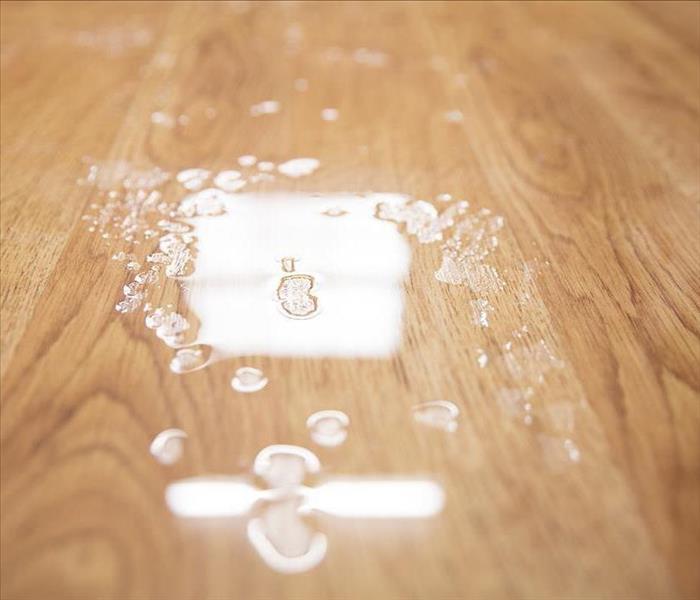 Here at SERVPRO, we want to be sure that you are prepared for any disaster that could come your way. If you ever experience a disaster, call our team.
Here at SERVPRO, we want to be sure that you are prepared for any disaster that could come your way. If you ever experience a disaster, call our team.
Winter is upon us! With that comes the cold temps and the freezing pipes. Keep the faucets dripping to keep some water traveling through, making it harder to freeze, but there are other ways to prevent freezing or bursting pipes!
Keeping the pipes insulated is essential! If getting proper insulation is impossible before a storm, then wadding up newspaper and duct tape can provide temporary insulation around pipes. If the water pipes are in the garage, then keep the garage door closed whenever possible, to prevent freezing air from getting in and dropping the temps even further. Maintaining a consistent temperature in the home will also help, as well as, keeping the heat on when leaving the home for any extended period of time.
These are just a few ways to prevent freezing pipes, but if there is ever a surprise pipe burst, SERVPRO is there to help with mitigating the water and getting your home back to the way it was before, "Like it never even happened."
Helping Mother Nature
11/9/2020 (Permalink)
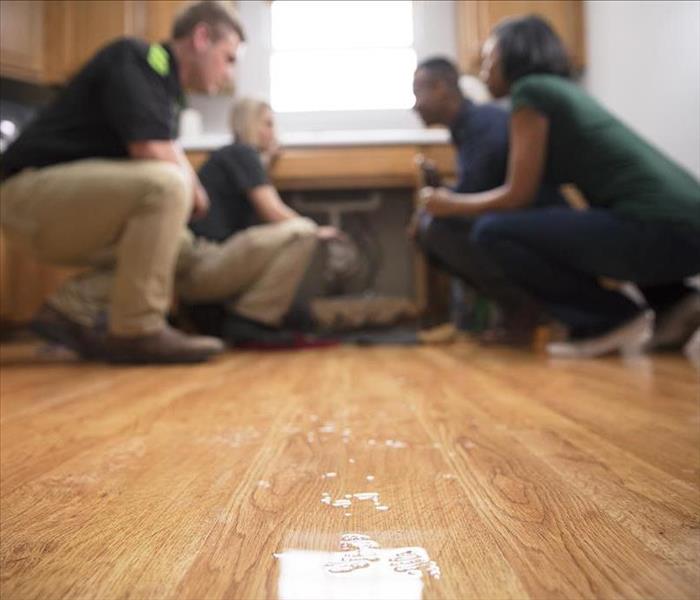 Our professional team is Here to Help® when Mother Nature is too much to handle. We know how stressful these situations can be.
Our professional team is Here to Help® when Mother Nature is too much to handle. We know how stressful these situations can be.
SERVPRO of Marshall, Sedalia and Columbia are trained in the science of drying water damages using psychrometry. We follow industry-approved standards to help lower the chances of any secondary damages.
Psychrometry is essential in restoring water damaged structure back to its preloss condition. So, what is psychrometry? It is the study of humidity, air flow, and temperature, and their effects on various materials or simply, the science of drying. It helps us determine what state-of-the-art equipment will be used.
When we arrive at the water damaged area in your home or business, we will:
- Inspect the building to detect migration of water, damage to materials, and condition of building.
- Measure how much moisture is in wet materials and monitor the materials through the drying process.
- Speed up Mother Nature by using professional drying equipment.
Mother Nature can allow wet materials to dry in the correct conditions. However, nature can take too long and create secondary damages.
Call SERVPRO of Marshall, Sedalia and Columbia to help speed up Mother Nature’s drying process with professional tools, equipment and knowledge.
Protect Your Home From Water Damage
9/18/2020 (Permalink)
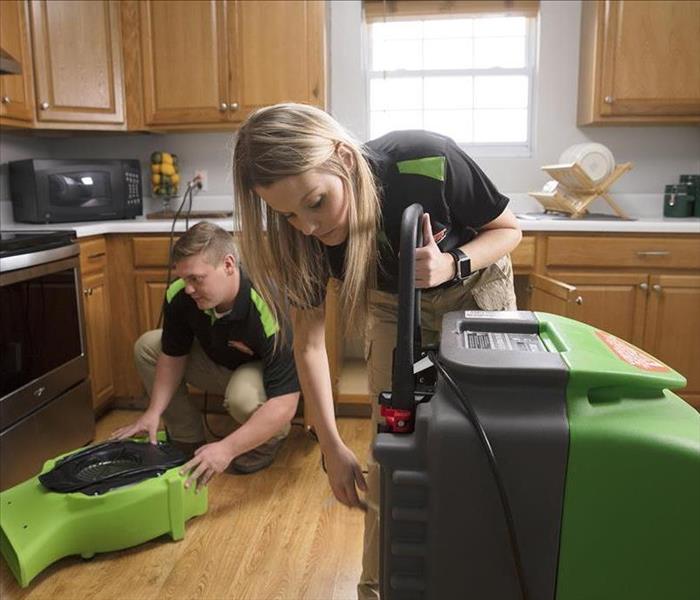 When you don't know what to do, call your local SERVPRO to help get you back to preloss conditions.
When you don't know what to do, call your local SERVPRO to help get you back to preloss conditions.
It’s 5pm, and you get home from a long day at work. You decide to go down to the basement to grab something from the freezer to make for supper. You get to the bottom and, smush, water everywhere!
What do you do? Say some choice words and think “Ugh, not today.”
In this case, call your insurance agent to let them know you have a claim to call in, then investigate where the water is coming from.
Water damage does not always come from a heavy rain or a storm. It can come from a broken pipe, an overflowing toilet or sink, a crack in the foundation where water may have been pooling. Once you know where the water is coming from, you can begin the steps to stop it and mitigate the damage.
If the water is indeed coming from a pipe or overflow, it is important to know where your water shutoff is in your home or business. Emergency Ready Profiles are available, and it’s a handy tool to know where it is and how to shut it off.
Once that is done, immediately call a restoration and cleaning company, like SERVPRO. Unless you have a water shop vac and a few air movers and dehumidifiers, it may take you awhile to clean it and we want to avoid mold at all costs. Mold growth can happen within days of the water damage, hence why mitigation is essential. The restoration company can do moisture readings and determine what is needed to dry the space, and get you back to where you were before the damage. They can also determine if any drywall or insulation will need to be replaced or removed to dry. This all happens while working with your insurance. Any reconstruction that may be needed will need to be done by a company that specializes in that but luckily, SERVPRO utilizes a company that can do those things.
It never hurts to do maintenance on any pipes or check on the water shut off, but in the case that something happens and you have water, those are some steps to take towards mitigation!
Our Water Damager Process
7/21/2020 (Permalink)
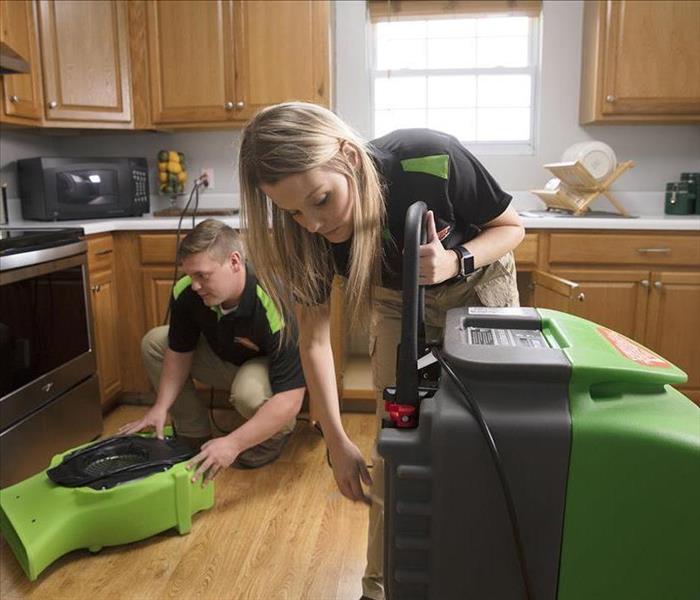 We are Here to Help no matter the day of the year. We are a professional cleanup group.
We are Here to Help no matter the day of the year. We are a professional cleanup group.
Every water damage is a little different, and entails a unique solution. However, the general process of a water damage stays the same. Listed below are the steps for a typical water damage emergency.
Step 1: Emergency Contact
Cleanup and restoration begin with a phone call. We have a representative to answer your phone call 24/7/365. They will lead you through several questions to better understand your needs of the water event.
Step 2: Inspection and Damage Assessment
Our SERVPRO professional completes a detailed inspection of your property and determine the scope of the damage.
Step 3: Water Removal/Water Extraction
This step removes the majority of the water from your home or business.
Step 4: Drying and Dehumidification
SERVPRO of Marshall, Sedalia, and Columbia professionals will manipulate temperature and relative humidity to remove the remaining moisture. Daily monitoring will occur until the materials reach an acceptable drying goal.
Step 5: Cleaning and Sanitizing
Walls, floors, and other surfaces of the property will likely need professional cleaning treatments once the area is dry. Restoring contents, odor removal and deodorization, and sanitizing treatments occur during this step.
Step 6: Restoration
This is the final step in the process of restoring your property to its pre-water damage condition.
The Different Types of Mold You'll Encounter
7/2/2020 (Permalink)
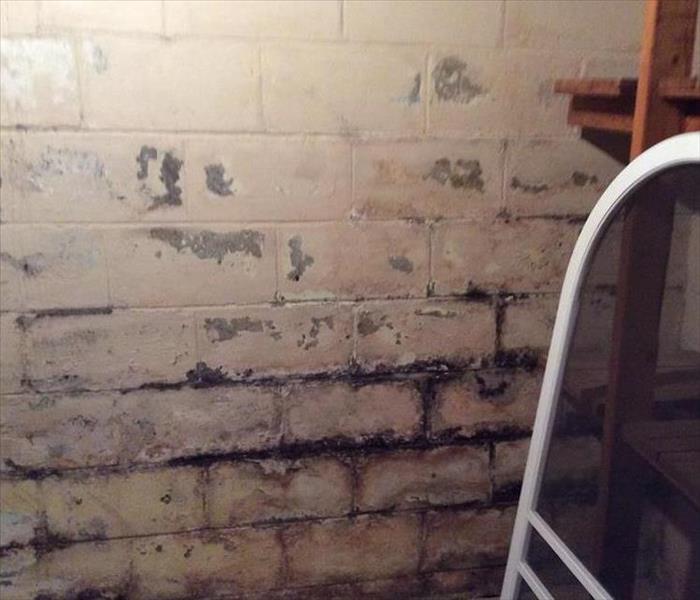 Mold prospers in warm, damp area and it will continue to spread with a continuous water source. Call our professionals to help with mold remediation.
Mold prospers in warm, damp area and it will continue to spread with a continuous water source. Call our professionals to help with mold remediation.
There are different types of mold. The most common are aspergillus, cladosporium and stachybotrys atra (also known as black mold). Aspergillus and Cladosporium are nontoxic to humans but it can aggravate allergy symptoms. It is important to note that not all mold is dangerous. In fact, it is all around us, but some mold should be removed by professionals. It is found in foods and in air conditioning systems. This is found as a black or green mold that grows in little dots in bathrooms, on painted surfaces, and in flexible air ducts. Black mold should be removed for safety reasons. Call our SERVPRO franchise professionals to remove molds such as black mold. This type of mold grows on building materials with a water source available. To prevent mold growth, make sure that water leaks are dried up quickly and humidity levels are maintained in your home or business. Mold thrives in warm, damp conditions. Our SERVPRO franchise professionals are certified to test for mold. We do visual inspections, air sampling, as well as we have a bore scope that can go inside areas that are not normally visible to look for mold. When air samples are taken, 3 samples are taken and sent in to be analyzed. The results take about 5 to 7 days to return. If the air samples come back positive for mold then we will do further investigation to locate the source of the positive result of the air samples. Call us for pricing if you believe you have mold present and we will help you maintain your healthy home remediate mold.
The Do's and Do Not's for Water Damage
7/1/2020 (Permalink)
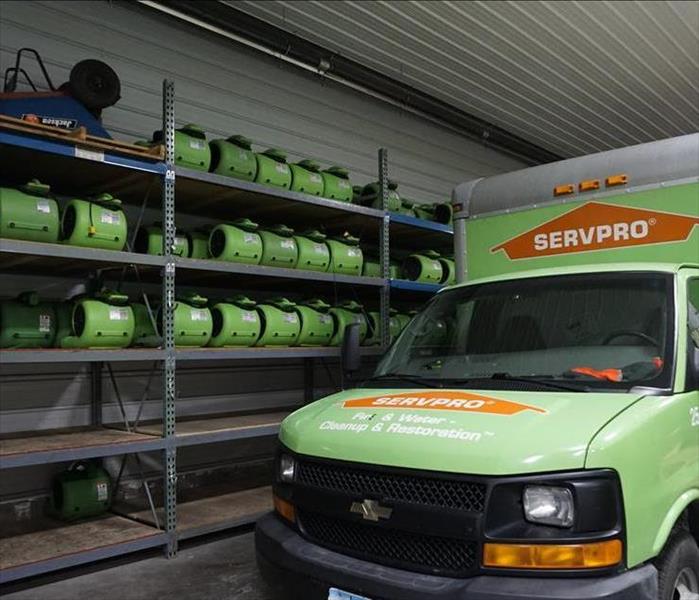 We are fully stocked for any amount of water damage. As franchise professionals, we can help you get toward preloss conditions.
We are fully stocked for any amount of water damage. As franchise professionals, we can help you get toward preloss conditions.
Water damage can happen at any point for anyone, home or business, resulting in sometimes irreversible damaged property. These do's are only for clean water and do not’s pertain to sewage water. Sewage water is treated differently since it causes different damage and requires a different cleanup process. We, the team of SERVPRO of Marshall, Columbia, and Sedalia, know the importance of having professionals helping you properly dry out your home after water damage. With the right tools and pieces of equipment our SERVPRO franchise professionals can safely dry out your home or business and the contents within it. If the proper methods are administered then it minimizes the removal of materials such as drywall (this is also dependent on how soon the water damage is being dealt with. To minimize the damage, make sure to shut off the source of water and turn off the electricity. It is essential to remove as much excess water as possible by mopping and soaking up with towels. This is especially important for wood furniture. To ensure that more damage isn't sustained by the furniture, place aluminum foil in between furniture legs and the carpet. While these are good steps, your safety is important, so make sure to NOT enter a room with standing water since there could be a risk of electrical shock. We take safety very seriously and we want to ensure your safety along with our own. Make sure to disconnect all power first. It is recommended to NOT leave rugs and furniture upholstery wet against one another, because the fabrics have the potential to bleed between each other. It is important to note that you should not be utilizing your household vacuum to try and suck up any water. If these tips are followed, then damage can be minimized and you will be better prepared for help to arrive. Remember to stay safe and get excess water cleaned up professionally to minimize the chance of mold growth.
The Water You Don't See
1/16/2020 (Permalink)
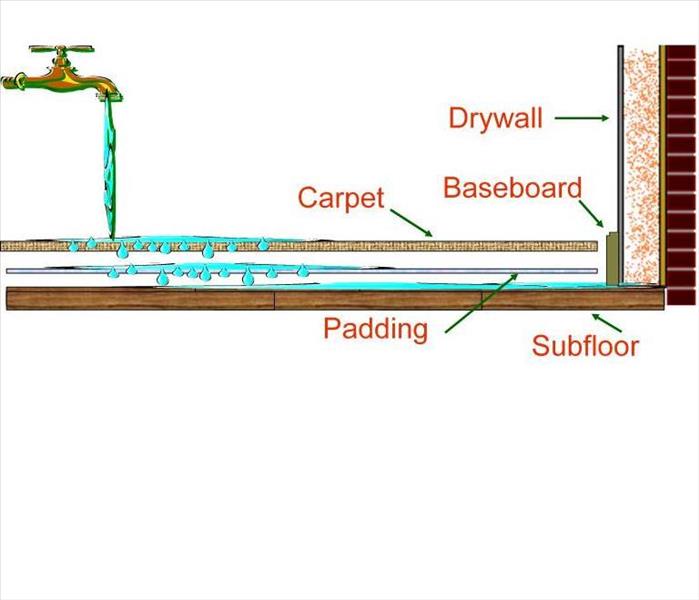 SERVPRO of Marshall, Sedalia and Columbia is Here to Help take care of the water you don't see.
SERVPRO of Marshall, Sedalia and Columbia is Here to Help take care of the water you don't see.
When you discover a water damage in your home or business, do you know where the water has traveled?
Water travels. It does not just stop on the surface where it is more obvious. It will travel from the carpet into the padding and make its way to the subfloor. Water can travel under the baseboard and climb the drywall. The drywall can soak up the water like a sponge.
This is why it is important to hire professionals to take care of your water emergency. SERVPRO of Marshall, Sedalia and Columbia will inspect and test the premises to determine the extent of the damage and how far the moisture has traveled. Our team wants to ensure proper and complete restoration, so you can go back to your normal lifestyle.
Overflowing Toilet Water Damage
11/11/2019 (Permalink)
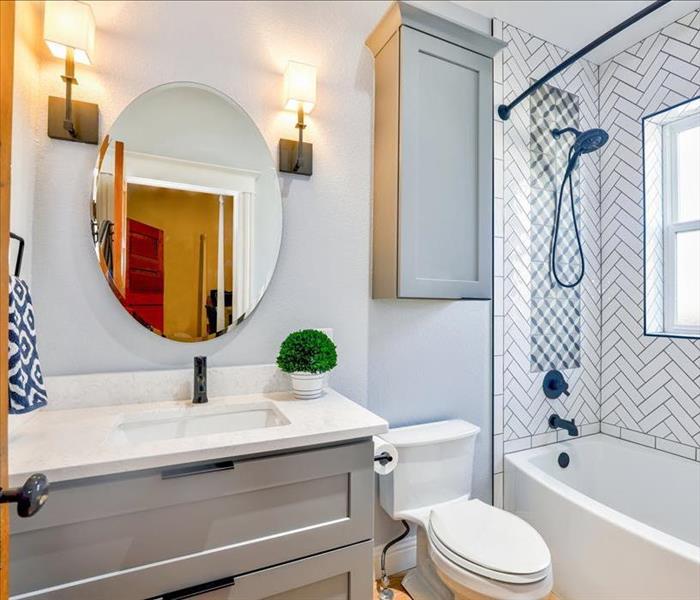 Overflowing toilets can be disastrous, so rely on the professionals at SERVPRO of Marshall, Sedalia and Columbia.
Overflowing toilets can be disastrous, so rely on the professionals at SERVPRO of Marshall, Sedalia and Columbia.
It is that time of the year, you know, the holiday season when we stuff everyone in the family in our homes for delicious, comforting meals. You may know to stay in the kitchen while cooking the amazing feast to prevent fire damage, but have you given much thought to your toilets?
Plumbing issues are at the top of the list for water damages. One of the plumbing issues is toilets overflowing. Toilets are more frequently used during the holiday season with the extra guests. Know what to do when your toilet starts overflowing with these tips:
- Adjust the float.
- Don’t keep flushing.
- Use a plunger.
- Turn off water to the toilet—QUICKLY. If the water is overflowing, this should be your first step.
- Call a plumber
- Call SERVPRO of Marshall, Sedalia and Columbia—your water cleanup and restoration professionals. We can safely cleanup any toilet water damage that has affected your home. Learn more about our sewage cleanup and restoration and the three types of contaminated water.
Reduce Toilet Water Damage by:
- Checking after you flush.
- Bi-annual maintenance. Check the components of toilet (supply valve, flush valve, fill, chain, etc.) to make sure they working.
- Know toilet water shut-off location.
If your toilet flooded your home, contact SERVPRO of Marshall, Sedalia and Columbia, your local water cleanup and restoration company. Our team has the experience, expertise, and equipment to ensure your home does not develop mold and is properly cleaned. We are Here to Help 24/7/365 because toilet overflows never happen at a convenient time.
Helping Mother Nature
9/2/2019 (Permalink)
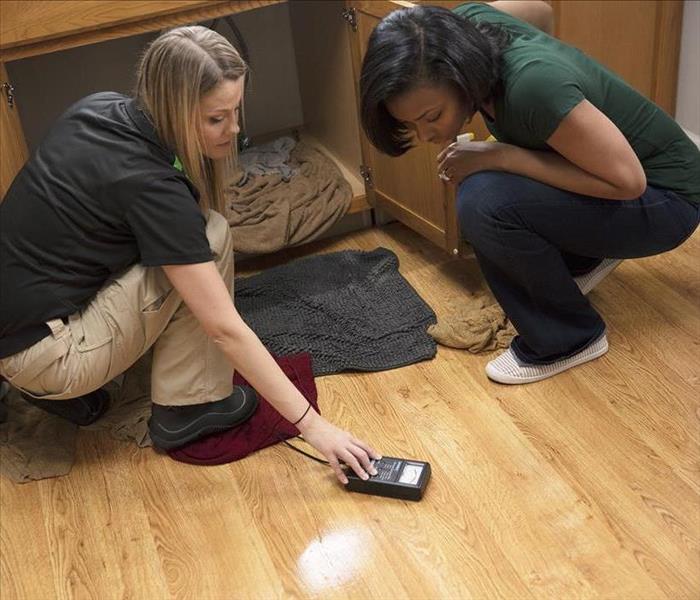 When you experience a water damage, contact your local professionals at SERVPRO of Marshall, Sedalia and Columbia.
When you experience a water damage, contact your local professionals at SERVPRO of Marshall, Sedalia and Columbia.
SERVPRO of Marshall, Sedalia and Columbia are trained in the science of drying water damages using psychrometry. We follow industry-approved standards to help lower the chances of any secondary damages.
Psychrometry is essential in restoring water damaged structure back to its preloss condition. So, what is psychrometry? It is the study of humidity, air flow, and temperature, and their effects on various materials or simply, the science of drying. It helps us determine what state-of-the-art equipment will be used.
When we arrive at the water damaged area in your home or business, we will:
- Inspect the building to detect migration of water, damage to materials, and condition of building.
- Measure how much moisture is in wet materials and monitor the materials through the drying process.
- Speed up Mother Nature by using professional drying equipment.
Mother Nature can allow wet materials to dry in the correct conditions. However, nature can take too long and create secondary damages.
Call SERVPRO of Marshall, Sedalia and Columbia to help speed up Mother Nature’s drying process with professional tools, equipment and knowledge.
Dishwasher Flooded Kitchen
6/24/2019 (Permalink)
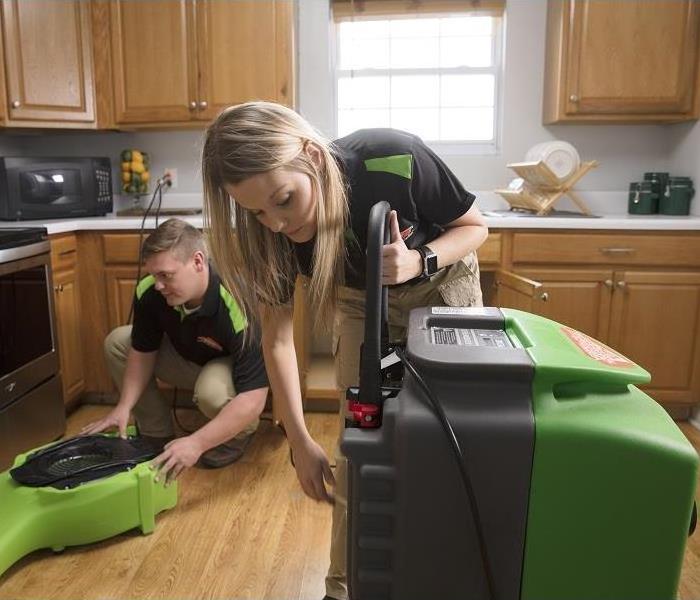 SERVPRO of Marshall, Sedalia and Columbia is Here to Help with your water damage needs.
SERVPRO of Marshall, Sedalia and Columbia is Here to Help with your water damage needs.
On the way out the door to go to work, you turn on the dishwasher. In your mind, that will be one item marked off your to do list. Unfortunately, when you arrive home you discovered that your dishwasher has flooded your kitchen. What should you do besides contact SERVPRO of Marshall, Sedalia and Columbia?
- Turn off the water.
- Safely turn off electricity to wet areas of the building.
- Remove as much excess water as possible.
Prevention
Save yourself a headache and take these simple steps to prevent a water damage from your dishwasher.
- Regularly maintain dishwasher
- Load it properly
- Use the right soap
- Only use when someone is home
Dishwashers can be very helpful taking loads of dishes off of our hands. If your dishwasher creates a water damage, call SERVPRO of Marshall, Sedalia and Columbia. Our highly trained professionals, are here to help 24/7.
Three Types of Water in Water Damages
4/15/2019 (Permalink)
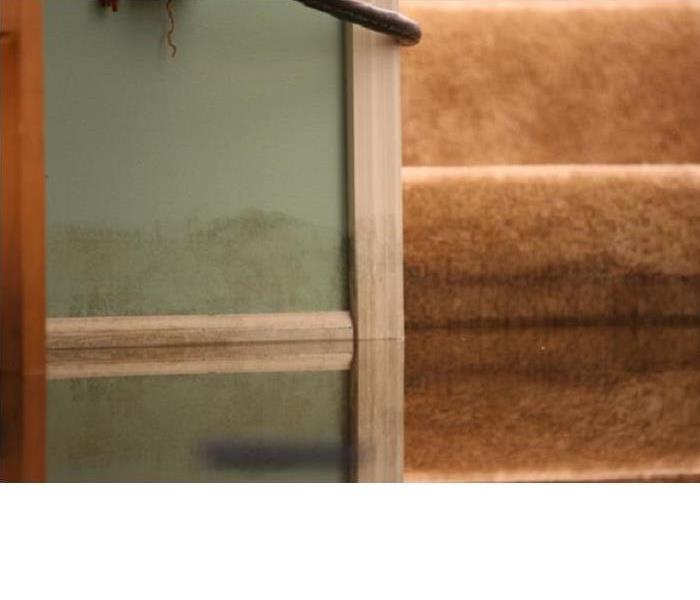 If you have a water damage, contact the professionals at SERVPRO of Marshall, Sedalia and Columbia.
If you have a water damage, contact the professionals at SERVPRO of Marshall, Sedalia and Columbia.
To ensure a proper cleanup of a water damage. The type of water must be determined.
Types of Water
Clean Water (Category 1)
Clean water is when the water originates from a sanitary water source. Examples of category 1 water can include: broken water supply lines; tub or sink overflows with no contaminants; and falling rainwater. It should not pose a substantial risk if exposed to water. Clean water can become gray or black water, if it is left untreated.
Gray Water (Category 2)
Gray water is when the water is slightly contaminated. Examples of category 2 water can include: discharge from dishwashers or washing machines; overflows from washing machines; and overflows from toilet bowls on the room side of the trap with some urine. It has the potential to cause discomfort or sickness if consumed. Gray water can become black water, if left untreated.
Black Water (Category 3)
Black water is highly contaminated and can contain fungi, bacteria, chemicals, or other harmful agents. Examples of category 3 water can include: sewage; flooding or any type of natural disaster. It can cause significant adverse reactions to humans if contacted or consumed. Blackwater should always be handled by the professionals.
When you have a water damage, do not leave your property to chance. Call SERVPRO of Marshall, Sedalia and Columbia. We take care of those in our community.
Ice Dams in Marshall, Sedalia, & Columbia
2/4/2019 (Permalink)
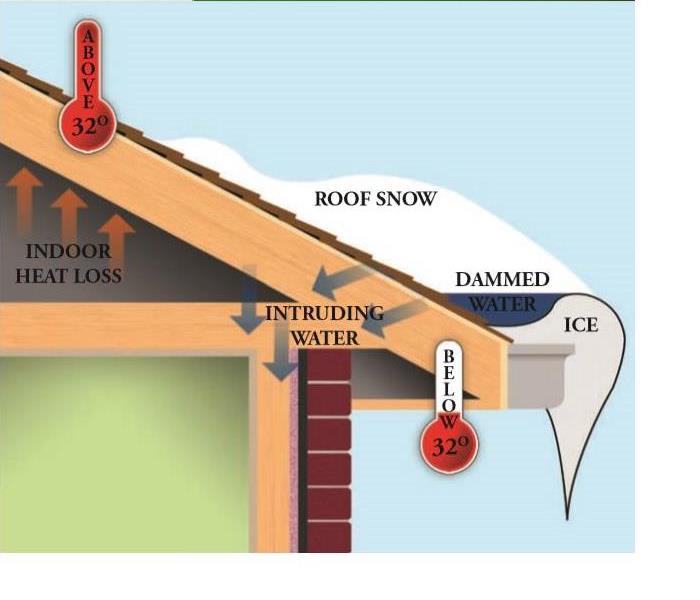 Demonstrates how ice dams form when snow begins to melt and temperatures are at freezing or below.
Demonstrates how ice dams form when snow begins to melt and temperatures are at freezing or below.
Ice dams form when:
- Snow is present on the roof.
- Temperature is above 32 degrees Fahrenheit on higher portion of the roof.
- Temperature is below 32 degrees Fahrenheit on lower portion of the roof.
Snow melts down the roof and freezes once it reaches the cooler portion of the roof. The dam grows from the melting snow and water begins to back up on top of the ice. The water tries to find a way to escape and back-flows under the roof’s shingles and into the structure’s interior.
Ice dams can cause significant water damage to ceilings, walls, insulation, and other areas of your home. If your home or business has been affected by winter damage, call SERVPRO® of Marshall, Sedalia, and Columbia. We are here to help those in our communities.
SERVPRO of Marshall, Sedalia, and Columbia Water Damage Restoration Process
11/27/2018 (Permalink)
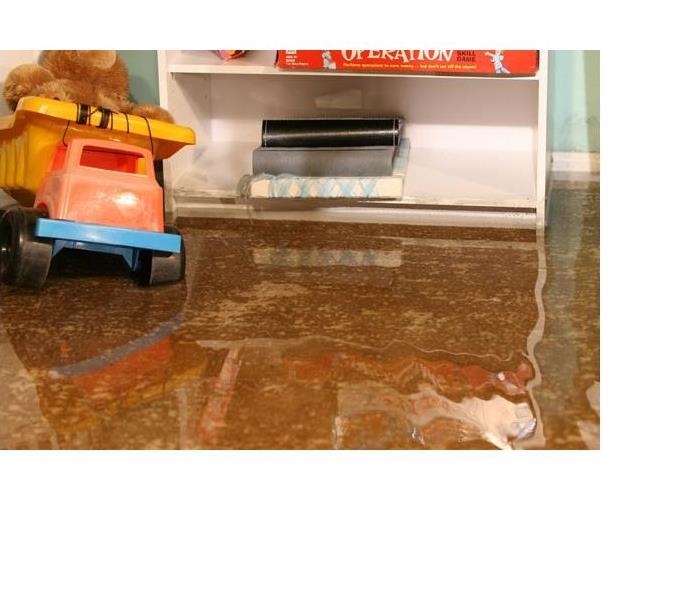 Trust SERVPRO of Marshall, Sedalia, and Columbia for your water damage needs.
Trust SERVPRO of Marshall, Sedalia, and Columbia for your water damage needs.
Every water damage is a little different, and entails a unique solution. However, the general process of a water damage stays the same. Listed below are the steps for a typical water damage emergency.
Step 1: Emergency Contact
Cleanup and restoration begin with a phone call. We have a representative to answer your phone call 24/7/365. They will lead you through several questions to better understand your needs of the water event.
Step 2: Inspection and Damage Assessment
Our SERVPRO professional completes a detailed inspection of your property and determine the scope of the damage.
Step 3: Water Removal/Water Extraction
This step removes the majority of the water from your home or business.
Step 4: Drying and Dehumidification
SERVPRO of Marshall, Sedalia, and Columbia professionals will manipulate temperature and relative humidity to remove the remaining moisture. Daily monitoring will occur until the materials reach an acceptable drying goal.
Step 5: Cleaning and Sanitizing
Walls, floors, and other surfaces of the property will likely need professional cleaning treatments once the area is dry. Restoring contents, odor removal and deodorization, and sanitizing treatments occur during this step.
Step 6: Restoration
This is the final step in the process of restoring your property to its pre-water damage condition.
Dos & Don’ts when Faced with a Water Damage in Marshall, Sedalia, & Columbia
9/4/2018 (Permalink)
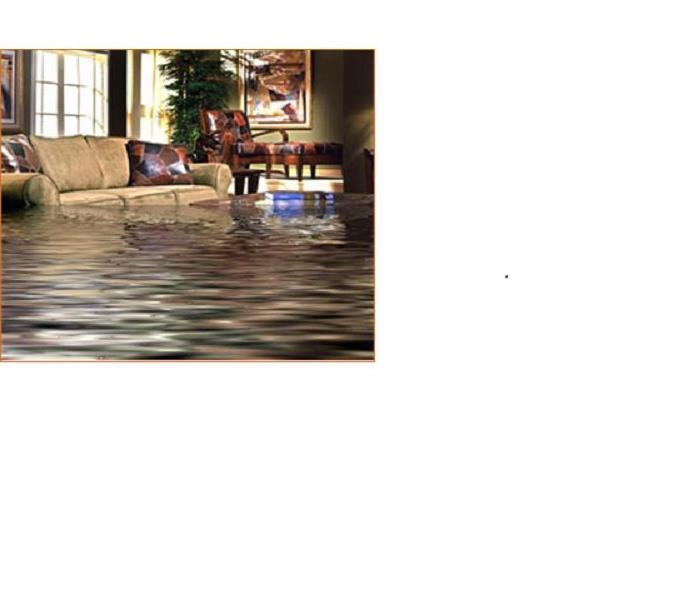 When faced with a water damage, call the professionals at SERVPRO of Marshall, Sedalia, and Columbia.
When faced with a water damage, call the professionals at SERVPRO of Marshall, Sedalia, and Columbia.
Imagine, you come home from a long day of work and are ready to relax and unwind. You head downstairs to grab some food from the freezer for dinner and notice all the water in your newly remodeled basement. Not the relaxing evening you were imagining. What do you do?
DO:
- Call your local restoration professionals at SERVPRO® of Marshall, Sedalia, and Columbia.
- Find the source of the water and shut it off, if possible or contact a qualified party to stop the source of the water.
- Turn off circuit breakers for wet areas of the building, when access to the power distribution panel is safe from electrical shock.
- Remove as much excess water as possible by mopping and blotting.
- Wipe excess water from wood furniture after removing lamps and tabletop items.
DON’T:
- Enter rooms with standing water where electrical hazards may exist.
- Enter affected areas if electrical equipment, electrical outlets, circuit breakers, or switches are exposed to water.
- Use your household vacuum cleaner to remove water. It could possibly cause electrical shock or damage to the vacuum.
- Turn on ceiling fixtures if ceiling is wet or enter rooms where ceilings are sagging from retained water.
- Leave books, magazines, or other colored items on wet carpets or floors. They may cause staining.
If you experience a water damage in your home or business, call SERVPRO® of Marshall, Sedalia, and Columbia. We cover Boone, Howard, Saline, Lafayette, Cooper, Pettis, and Johnson counties. Our professional technicians are trained and understand how to manage the drying process. We never expect a water damage to happen, but if it does, call the team that can make it “Like it never even happened.”
Sewer Backups in Marshall, Sedalia, & Columbia
4/2/2018 (Permalink)
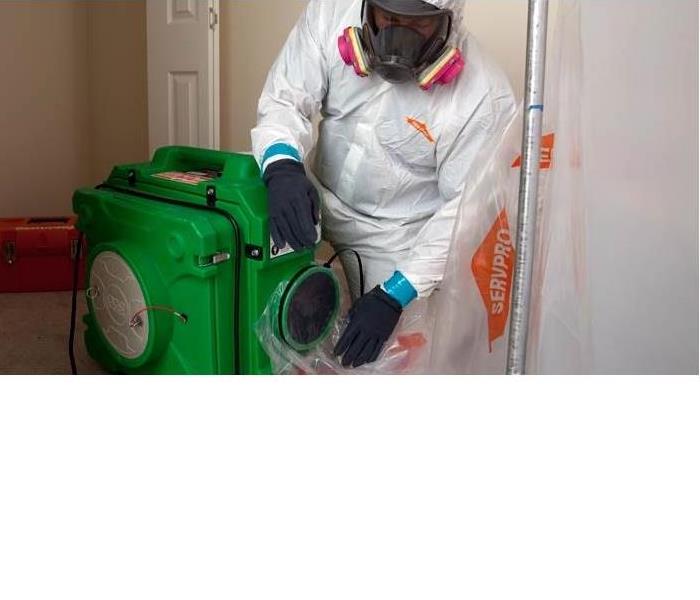 Have you experienced a sewer backup? Contact the professionals at SERVPRO of Marshall, Sedalia, and Columbia to make it "Like it never even happened."
Have you experienced a sewer backup? Contact the professionals at SERVPRO of Marshall, Sedalia, and Columbia to make it "Like it never even happened."
Sewer Backup—What is It and Am I Covered?
A sewer backup occurs when sewage from sanitary sewer lines back up into homes and businesses through drain pipes. Backups create damage to the structure of the property, contents, and can create health hazards.
According to the Insurance Information Institute, most homeowner and business insurance policies do not cover sewer backup. Typically, a specific sewer backup coverage needs to be added to your policy. For most insurers, this is a nominal cost on your annual insurance policy.
There are several causes for a sewer backup to occur in your property. Some include:
- Blockages from Tree Roots
- Sanitary Main Blockages
- Aging Sewer Systems
- Combined Pipelines
What can you do to help prevent backups?
- Dispose of grease and paper products properly
- Cut back tree roots periodically
- Replace your line with new plastic pipe
- Correct any illegal plumbing connections
- Install a backwater prevention valve
Experiencing a sewer backup?
In the event of a backup, immediately arrange services for the cleanup of your property by contacting SERVPRO of Marshall, Sedalia, and Columbia at 660-886-5194.
Tips on What to Do Until SERVPRO Help Arrives
- Avoid all contact with sewage and items contaminated by sewage.
- Wash your hands thoroughly after contact with contaminated items.
- Do not spread contaminated water by walking unnecessarily on damaged or wet areas.
- Do not turn on the HVAC system if there is a chance of spreading contaminated air.
- Do not use household fans to dry the structure and spread contaminants.
Winter Tips to Prevent Frozen Pipes Bursting
12/28/2017 (Permalink)
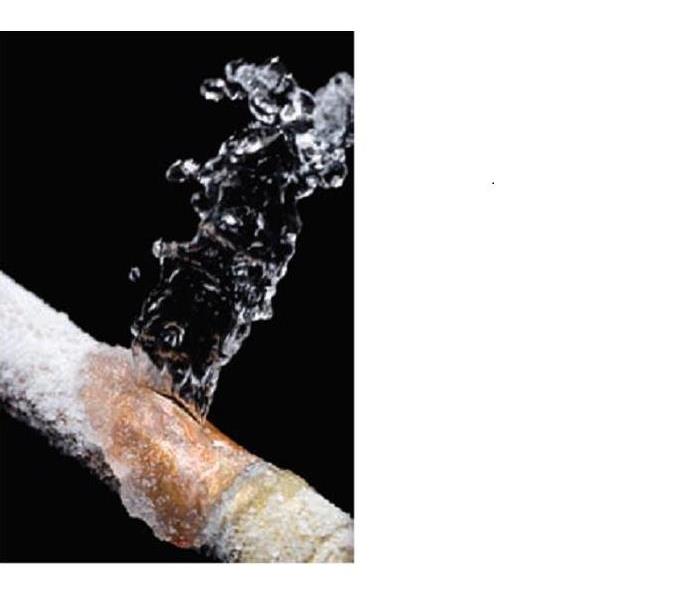 SERVPRO® of Marshall, Sedalia, and Columbia can respond faster to your frozen water pipe disaster.
SERVPRO® of Marshall, Sedalia, and Columbia can respond faster to your frozen water pipe disaster.
The temperatures have been dropping and the winter weather is here. When the temperatures go below freezing level, your property is at risk for frozen pipes, which can create a major disaster in your home or business.
Be Prepared
- Know where your water shut off is located, in case of a frozen water pipe burst.
- Insulate exposed pipes in your home or business, especially if they are in unheated rooms.
- Open bathroom and kitchen cabinet doors during cold spells to allow warmer air to circulate around the plumbing.
- During extremely cold weather, keep a slow trickle of water flowing through faucets. Running water is less likely to freeze.
- Consider shutting off outdoor faucets and open the outdoor faucet to help ensure it completely drains and the inner valve is shut off.
- Keep your heat set to the same temperature both day and night.
- If you plan on being away from your property for an extended period of time, leave the heat on and set the thermostat to at least 55°F.
Discovered Frozen Pipe
- First sign of freezing is reduced water flow from a faucet.
- Keep the faucet open when treating frozen pipes.
- Apply heat to the frozen sections using a heating pad, hair drier, or another safe heat source. Do not use an open flame device.
- Check additional pipes and faucets for freezing.
When a Pipe Bursts
- Shut off the water at the main valve.
- Call your local restoration professionals, SERVPRO® of Marshall, Sedalia, and Columbia.
A burst pipe can cause considerable damage to your property if not addressed quickly. If winter weather causes water damage to your home or business, call SERVPRO® of Marshall, Sedalia, and Columbia. We are available 24/7/365 and are ready to restore your property to preloss condition.
Marshall, Sedalia, & Columbia 24 Hour Emergency Water Damage Service
8/24/2016 (Permalink)
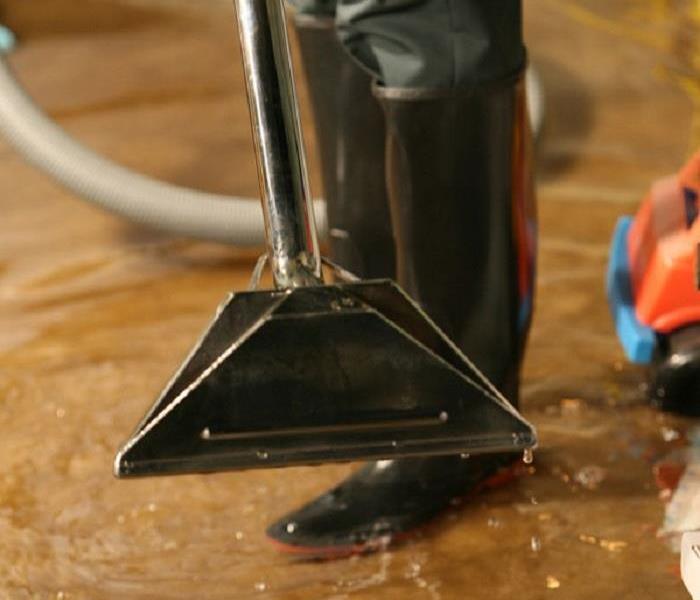 SERVPRO of Marshall, Sedalia, and Columbia provides 24 hour fire and water damage restoration service.
SERVPRO of Marshall, Sedalia, and Columbia provides 24 hour fire and water damage restoration service.
SERVPRO of Marshall, Sedalia, and Columbia is available 24 hours a day for water emergencies, large or small. When you are dealing with water damage, immediate action is crucial. A delay of just a few hours can greatly increase the severity of the water damage.
We Answer the Phone Ready to Help
Call Today - 660-886-5194
We understand that when you call us, you may be feeling confused, stressed, and vulnerable. You need an expert to guide you through this crisis. SERVPRO of Marshall, Sedalia, and Columbia has the specific water damage training and experience to help you through this tough time. We specialize in water damage restoration—in fact, it's the cornerstone of our business.
What to Expect
When you call, we will ask several questions regarding your water damage emergency. These questions will help us determine what equipment and resources to bring, including how many trained SERVPRO Professionals may be needed.
Our SERVPRO Representative will ask several questions:
- Your name and contact information
- Your insurance information (if applicable)
- The street address of the water-damaged home or business
- When did the flooding or water damage occur?
- What caused the water damage (if known)?
- Is there electricity available (on-site)?
About SERVPRO of Marshall, Sedalia, and Columbia
SERVPRO of Marshall, Sedalia, and Columbia specializes in the cleanup and restoration of residential and commercial property after a fire, smoke or water damage event. Our staff is highly trained in property damage restoration. From initial and ongoing training at SERVPRO’s corporate training facility to regular IICRC-industry certification, rest assured our staff is equipped with the knowledge to restore your property.
 If your property needs to be evaluated for water damage call SERVPRO of Marshall, Sedalia and Columbia at 660-886-5194.
If your property needs to be evaluated for water damage call SERVPRO of Marshall, Sedalia and Columbia at 660-886-5194.





 24/7 Emergency Service
24/7 Emergency Service























